Charles E W Bean, Diaries, AWM38 3DRL 606/88/1 - September 1917 - Part 1

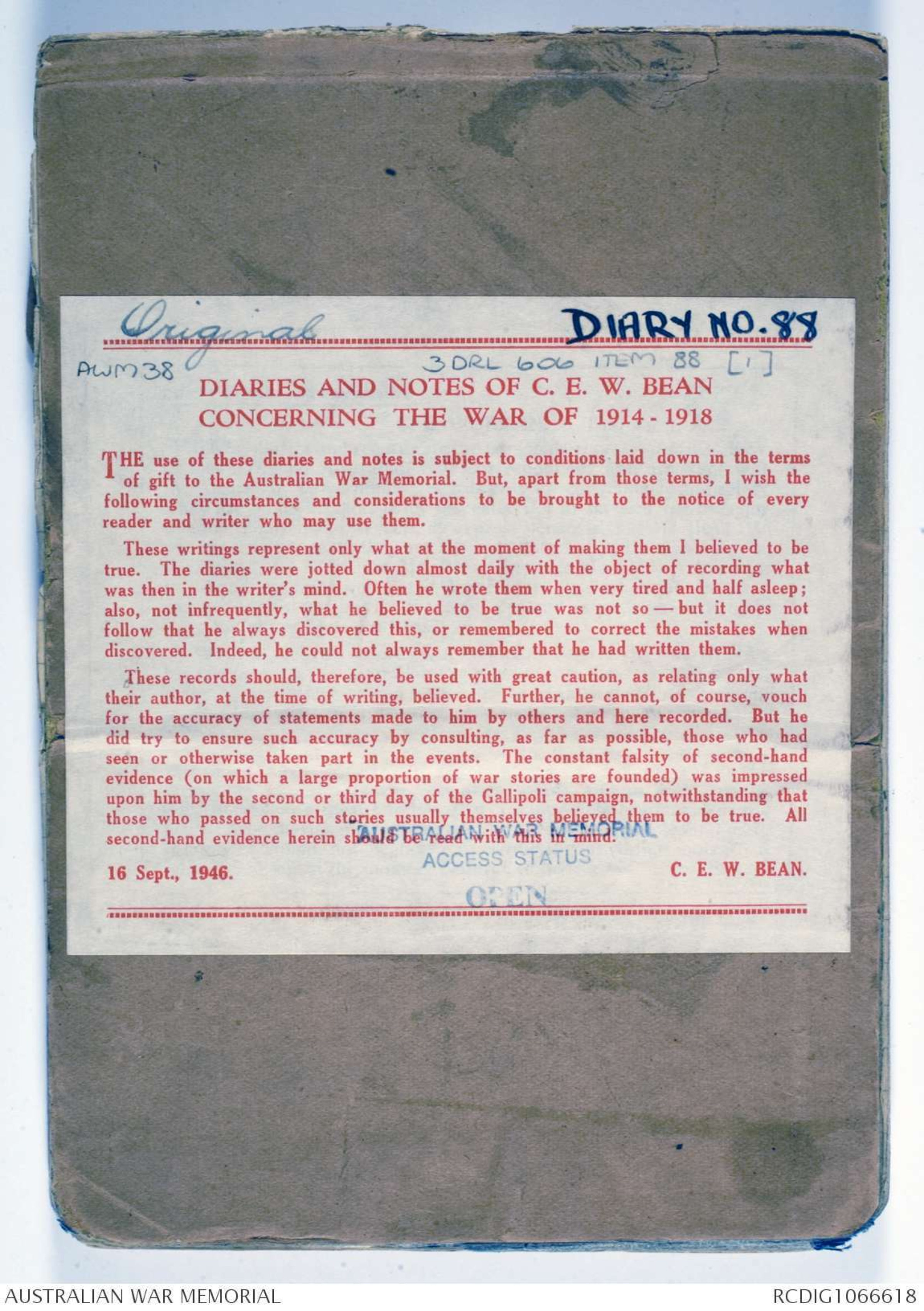
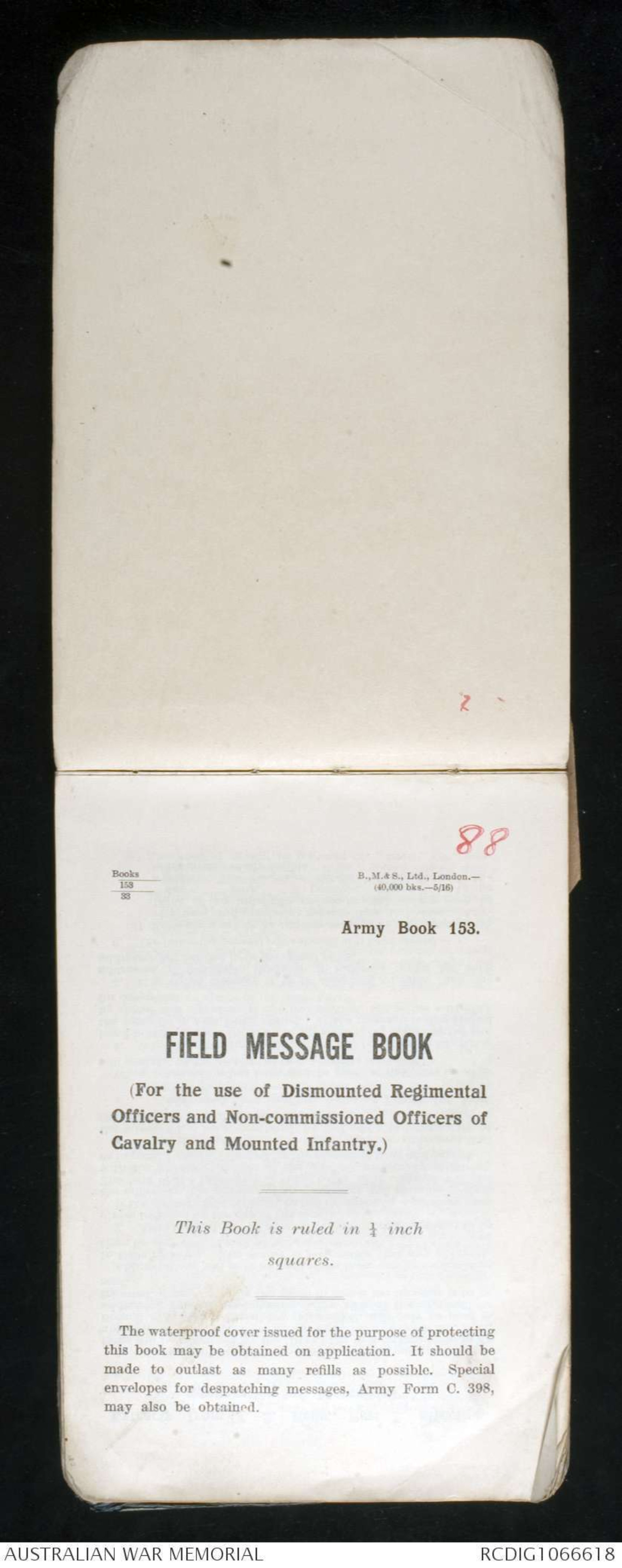
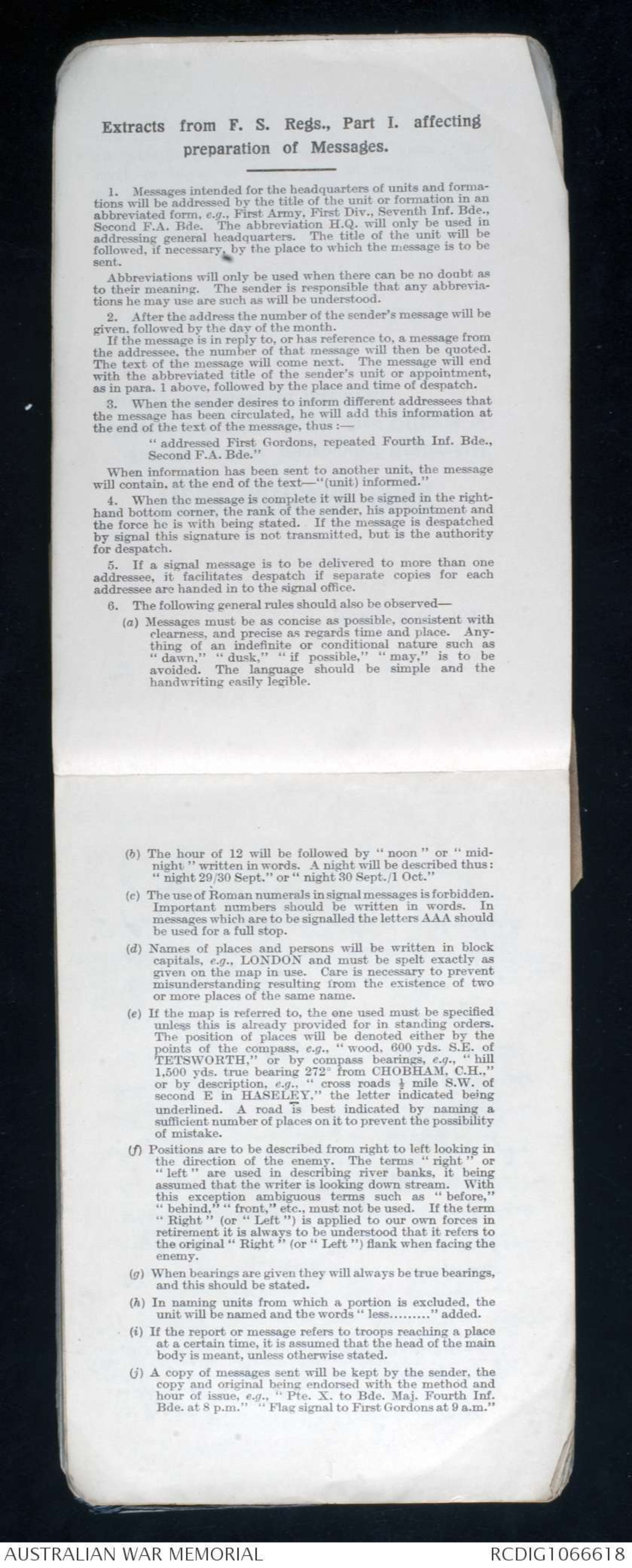
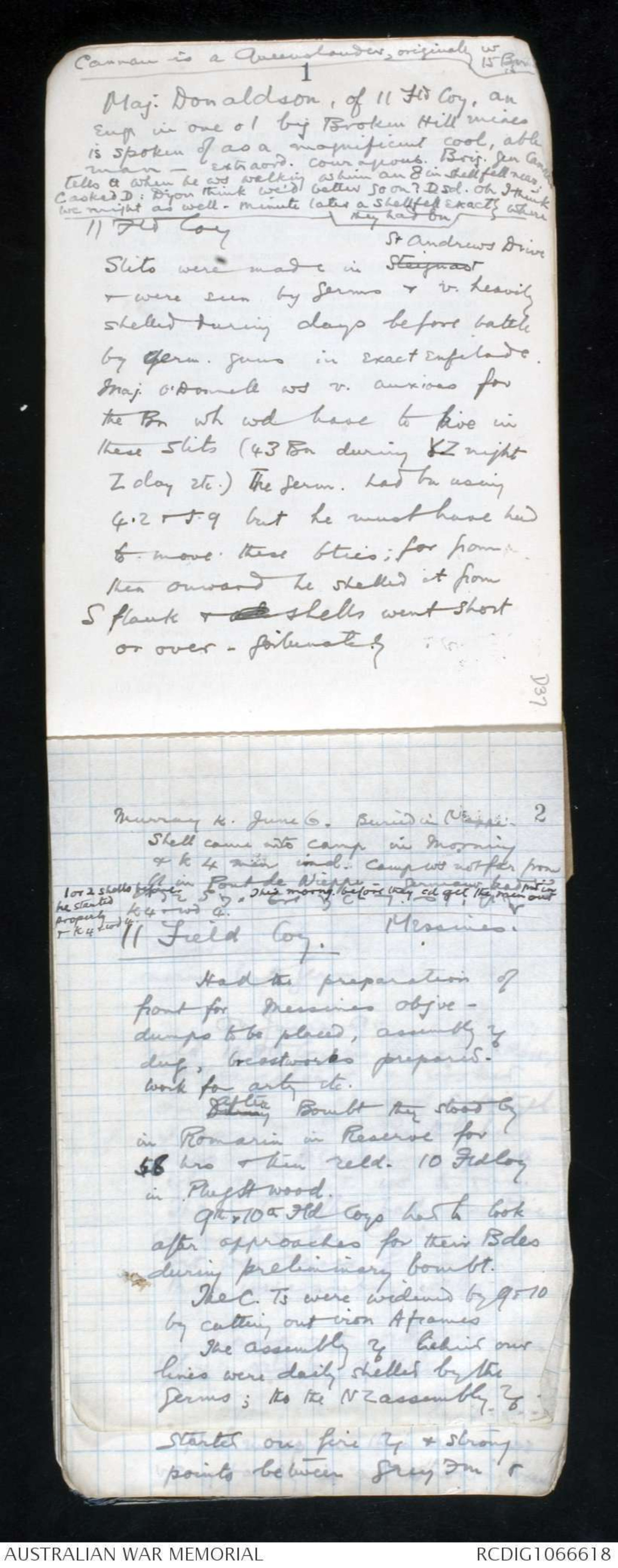
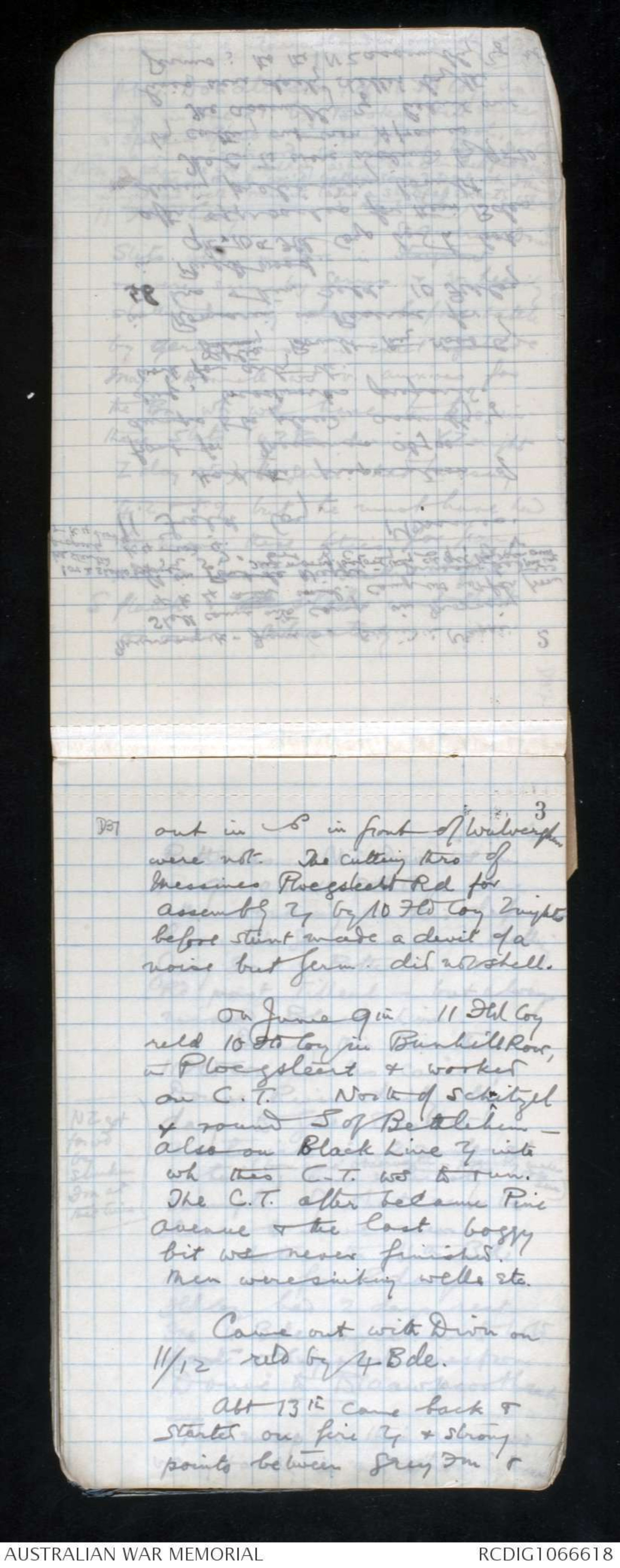
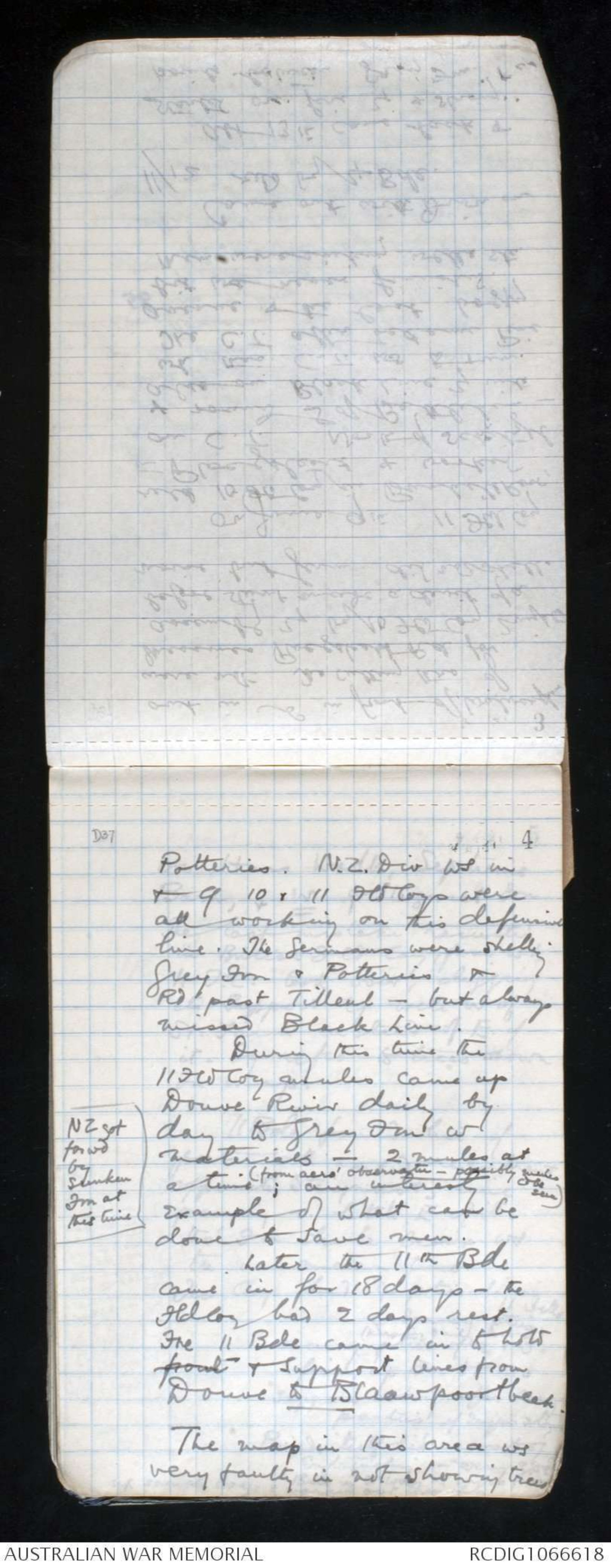

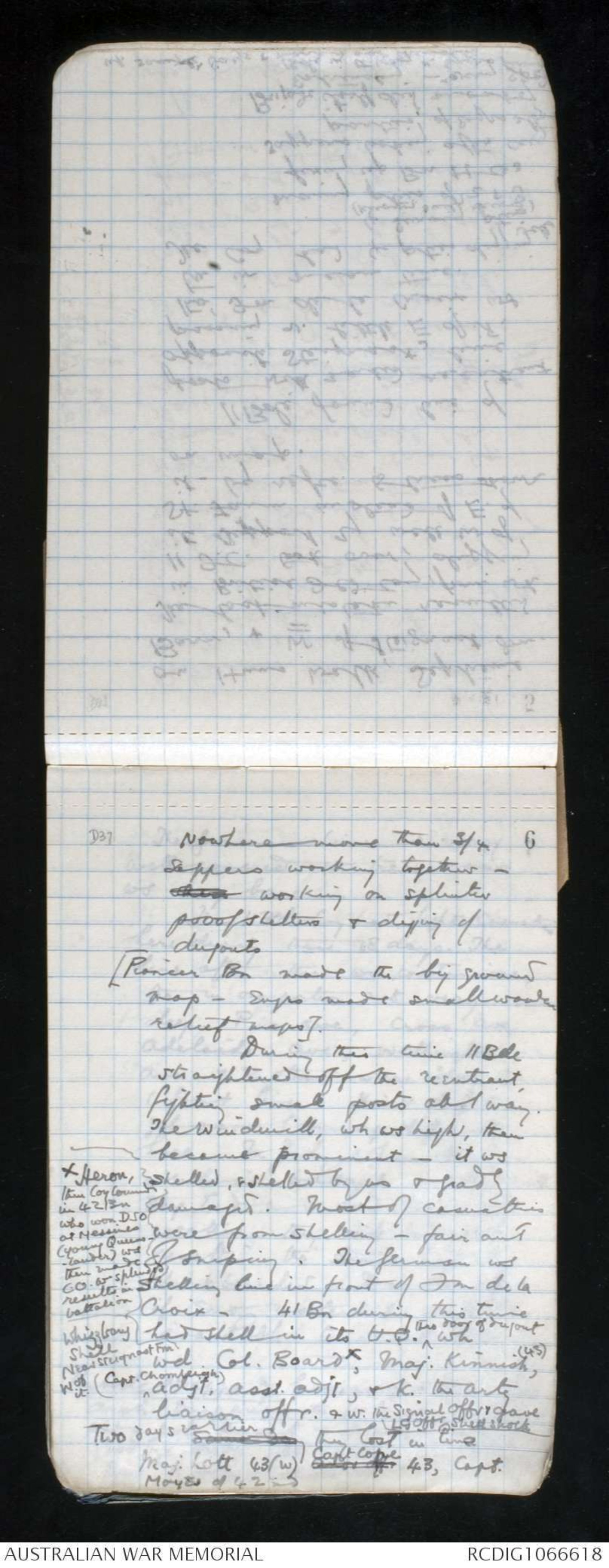
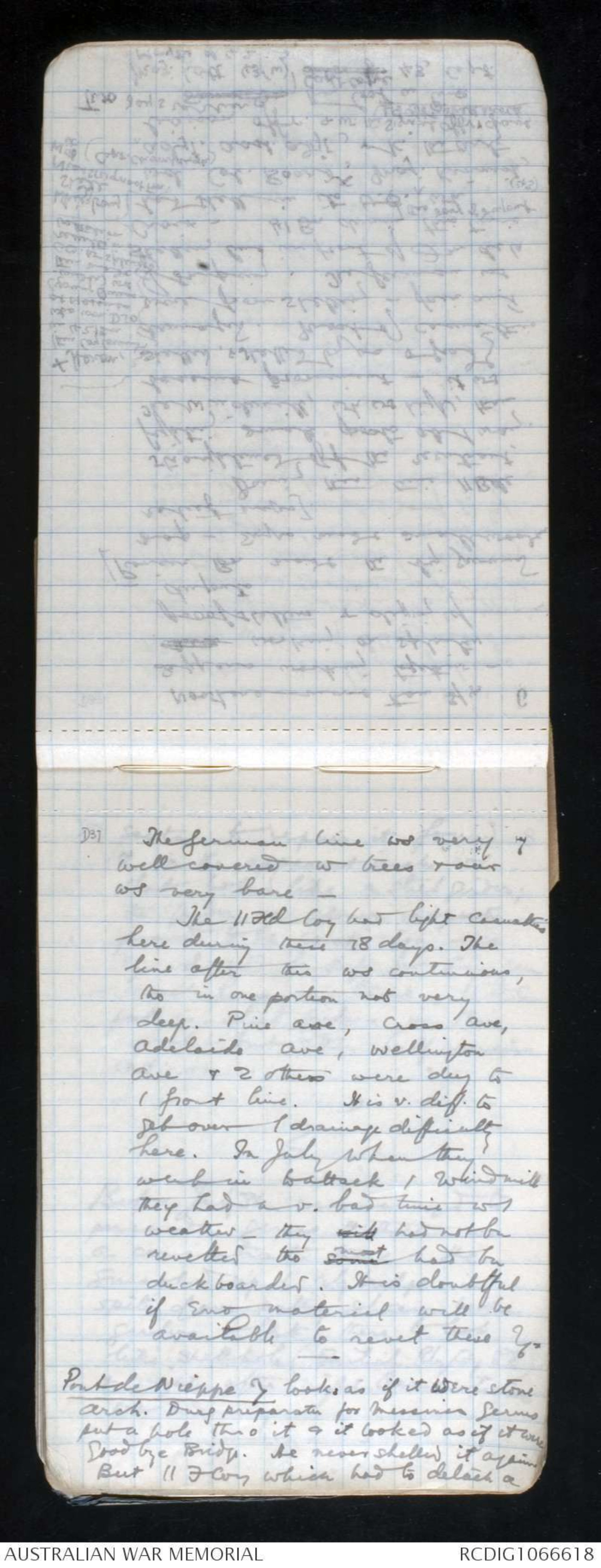
AWM38
Official History,
1914-18 War: Records of C E W Bean,
Official Historian.
Diaries and Notebooks
Item number: 3DRL606/88/1
Title: Diary, September 1917
Includes references to the 43rd and 44th
Battalions, 7th Battery, 11th Field Company
Messines, Rockcliffe, Ypres and Gallipoli.
AWM38-3DRL606/88/1
Original
DIARY NO. 88
AWM38
3DRL 606 ITEM 88 [1]
DIARIES AND NOTES OF C. E. W. BEAN
CONCERNING THE WAR OF 1914 - 1918
THE use of these diaries and notes is subject to conditions laid down in the terms
of gift to the Australian War Memorial. But, apart from those terms, I wish the
following circumstances and considerations to be brought to the notice of every
reader and writer who may use them.
These writings represent only what at the moment of making them I believed to be
true. The diaries were jotted down almost daily with the object of recording what
was then in the writer’s mind. Often he wrote them when very tired and half asleep;
also, not infrequently, what he believed to be true was not so —but it does not
follow that he always discovered this, or remembered to correct the mistakes when
discovered. Indeed, he could not always remember that he had written them.
These records should, therefore, be used with great caution, as relating only what
their author, at the time of writing, believed. Further, he cannot, of course, vouch
for the accuracy of statements made to him by others and here recorded. But he
did try to ensure such accuracy by consulting, as far as possible, those who had
seen or otherwise taken part in the events. The constant falsity of second-hand
evidence (on which a large proportion of war stories are founded) was impressed
upon him by the second or third day of the Gallipoli campaign, notwithstanding that
those who passed on such stories usually themselves believed them to be true. All
second-hand evidence herein should be read with this in mind.
AUSTRALIAN WAR MEMORIAL
ACCESS STATUS
OPEN
16 Sept., 1946. C. E. W. BEAN.
88
B.,M.&S., Ltd., London.—
(40,000 bks.-5/16)
Books
--------
153
--------
33
Army Book 153.
FIELD MESSAGE BOOK
(For the use of Dismounted Regimental
Officers and Non-commissioned Officers of
Cavalry and Mounted Infantry.)
This Book is ruled in 1/4 inch
squares.
The waterproof cover issued for the purpose of protecting
this book may be obtained on application. It should be
made to outlast as many refills as possible. Special
envelopes for despatching messages, Army Form C. 398,
may also be obtained.
Extracts from F. S. Regs., Part I. affecting
preparation of Messages.
--------
1. Messages intended for the headquarters of units and formations
will be addressed by the title of the unit or formation in an
abbreviated form, e.g., First Army, First Div., Seventh Inf. Bde.,
Second F.A. Bde. The abbreviation H.Q. will only be used in
addressing general headquarters. The title of the unit will be
followed, if necessary, by the place to which the message is to be
sent.
Abbreviations will only be used when there can be no doubt as
to their meaning. The sender is responsible that any abbreviations
he may use are such as will be understood.
2. After the address the number of the sender’s message will be
given, followed by the day of the month.
If the message is in reply to, or has reference to, a message from
the addressee, the number of that message will then be quoted.
The text of the message will come next. The message will end
with the abbreviated title of the sender’s unit or appointment,
as in para. 1 above, followed by the place and time of despatch.
3. When the sender desires to inform different addressees that
the message has been circulated, he will add this information at
the end of the text of the message, thus :-
"addressed First Gordons, repeated Fourth Inf. Bde.,
Second F.A. Bde."
When information has been sent to another unit, the message
will contain, at the end of the text—"(unit) informed."
4. When the message is complete it will be signed in the right-
hand bottom corner, the rank of the sender, his appointment and
the force he is with being stated. If the message is despatched
by signal this signature is not transmitted, but is the authority
for despatch.
5. If a signal message is to be delivered to more than one
addressee, it facilitates despatch if separate copies for each
addressee are handed in to the signal office.
6. The following general rules should also be observed-
(a) Messages must be as concise as possible, consistent with
clearness, and precise as regards time and place. Anything
of an indefinite or conditional nature such as
"dawn," "dusk," "if possible," "may," is to be
avoided. The language should be simple and the
handwriting easily legible.
(b) The hour of 12 will be followed by "noon" or "mid-
night" written in words. A night will be described thus:
"night 29/30 Sept." or "night 30 Sept. /1 Oct."
(c) The use of Roman numerals in signal messages is forbidden.
Important numbers should be written in words. In
messages which are to be signalled the letters AAA should
be used for a full stop.
(d) Names of places and persons will be written in block
capitals, e.g., LONDON and must be spelt exactly as
given on the map in use. Care is necessary to prevent
misunderstanding resulting from the existence of two
or more places of the same name.
(e) If the map is referred to, the one used must be specified
unless this is already provided for in standing orders.
The position of places will be denoted either by the
points of the compass, e.g., "wood, 600 yds. S.E. of
TETSWORTH," or by compass bearings, e.g., " hill
1,500 yds. true bearing 272° from CHOBHAM, C.H.,"
or by description, e.g., "cross roads ½ mile S.W. of
second E in HASELEY." the letter indicated being
underlined. A road is best indicated by naming a
sufficient number of places on it to prevent the possibility
of mistake.
(f) Positions are to be described from right to left looking in
the direction of the enemy. The terms "right" or
"left" are used in describing river banks, it being
assumed that the writer is looking down stream. With
this exception ambiguous terms such as "before,"
"behind," "front," etc., must not be used. If the term
"Right" (or "Left") is applied to our own forces in
retirement it is always to be understood that it refers to
the original "Right" (or "Left") flank when facing the
enemy.
(g) When bearings are given they will always be true bearings,
and this should be stated.
(h) In naming units from which a portion is excluded, the
unit will be named and the words " less........." added.
(i) If the report or message refers to troops reaching a place
at a certain time, it is assumed that the head of the main
body is meant, unless otherwise stated.
(j) A copy of messages sent will be kept by the sender, the
copy and original being endorsed with the method and
hour of issue, e.g., "Pte. X. to Bde. Maj. Fourth Inf.
Bde. at 8 p.m." "Flag signal to First Gordons at 9 a.m."
Cannan is a Queenslander, originally w 15th Bn.
1
Maj. Donaldson, of 11 Fld Coy, an
Engr in one o the big Broken Hill mines
is spoken of as a magnificent cool, able
man - extraord. courageous. Brig. Gen Cannan
tells a when he was walking w him an 8 in shell fell near;
C asked D : D’you think we'd better go on? D sd. Oh I think
we might as well - minute later a shell fell exactly where
they had bn
11 Fld Coy
Slits were made in Steignast St Andrews Drive
& were seen by Germs & v. heavily
shelled during days before battle
by germ. guns in exact enfilade.
Maj. O'Donell ws v. anxious for
the Bn wh wd have to live in
these slits (43Bn during YZ night
Z day etc.) The Germ. had bn using
4.2 & 5.9 but he must have had
to move these bties; for from
then onward he shelled it from
S flank & all shells went short
or over – fortunately.
D37
Murray K. June 6. Buried in Nieppe 2
Shell came into camp in morning
& k 4 men incl. camp ws not far from
trench in Pont de Nieppe – German had put in
1 or 2 shells before he started properly & k 4 & wd 4. This morning before they cd get the men out.
11 Field Coy. Messines.
Had the preparation of
front for Messines objve –
dumps to be placed, assembly trench
dug, breastworks prepared,
work for arty etc. During After Bombt they stood by
in Romarin in Reserve for
58 hrs & then reld. 10 FldCoy
in Plug St wood.
9th 10th Fld Coys had to look
after approaches for their Bdes
during preliminary bombt.
The C. Ts were widened by 9&10
by cutting out iron A frames
The assembly trenches behind our
lines were daily shelled by the
Germs ; tho the NZ assembly trenches
started on fire trench & strong
points between Grey Fm &
D37 were out in [[shorthand]] in front of Wulverghem 3
were not. The cutting thro of
Messines Ploegsteert Rd for
Assembly trench by 10 Fld Coy 2 nights
before stunt made a devil of a
noise but Germ. did not shell.
On June 9th 11 Fld Coy
reld 10 Fld Coy in Bunhill Row
in Ploegsteert & worked
on C.T. North of schnitzel
& round S of Bethlehem –
also on Black Line trench into
wh this C.T. ws to run.
The C.T. after became Pine
Avenue & the last boggy
bit was never finished.
Men were sinking wells etc.
Came out with Divn on
11/12 reld by 4 Bde.
Abt 13th came back &
started on fire trench & strong
points between Grey Fm &
D37 4
Potteries. N.Z. Div ws in
& 9 10 & 11 Fld Coys were
all working on this defensive
line. The Germans were shelling
Grey Fm & Potteries -
Rd past Tilleul – but always
missed Black Line.
During this time the
11 Fld Coy mules came up
Douve River daily by
day to Grey Fm w
materials - 2 mules at
a time ^(from aero’ observation - possibly mules cd be seen) an interesting
example of what can be
done to save men.
[*NZ got forwd by Sunken Fm at this time*]
Later the 11th Bde
came in for 18 days – the
Fld Coy had 2 days rest.
The 11 Bde came in to hold front & support lines from
Douve & Blaawpoortbeak,
The map in this area ws
very faulty in not showing trees
D87 5
on Huns walk, Septieme
Barn, & W of Steignast Fm.
The last mistake resulted
in British Fld Coy, from wh
11 F.C. took over, digging
its support trench well w of
St. Farm instead of E of
it by refce to trees shown
on map.
11 Bde found line of
posts with marked re entrant
opposite Steignast, line
passing through little E. of it.
tho' fm de la Croix ws
tn in meantime.
the Coy had 4 pties digging wells
4 survey pties
(keeping daily recon)
Many pties of 2 or 3
fixing up BN HQ
sappers looking after carry
parties of Engrs store
Brigade itself did most of
entrenching - "very good
Bde in tt way" Engrs fired
up sample bays & marked out their trenches
D37 Nowhere more than 3/4 6
sappers working together - xxx working on splinter
proof shelters & digging of
dugouts
[Pioneer Bn made the big ground
map - Engrs made small wooden
relief maps]
During this time 11 Bde
straightened off the re entrant,
fighting small posts all the way.
The windmill wh ws high, then
became prominent - it ws
shelled & shelled by us & badly
damaged.
[* x Heron,
then Coy Commander
in 42Bn
who won DSO
at Messines
(young Queenslander) ws
then made
CO w splendid
results in battalion *]
Most of casualties
were from shelling - fair amt
of sniping. The German ws
shelling line in front of Fm de la
Croix. 41 Bn during this time
had shell in its H.Q. ^ thro roof of dugout wh
wd Col Board, X Maj. Kinnish, (43)
[*whizzbang shell
near Stugnast Fm
W of it*]
^(Capt. Chomleigh) adjt. asst. adjt, & k the arty
liaison offr. & w. the signal offr & gave
LG offr shell shock
Two days earler xxxx they lost in line
Major Lott 43 (w) xxxx Capt Cope 43, Capt.
Moyes of 42nd
D37 The German line ws very 7
well covered w trees & our
ws very bare -
The 11Fd Coy had light casualties
here during these 18 days. The
line after this ws continuous,
tho in one portion not very
deep. Pine Ave, Cross Ave,
Adelaide Ave, Wellington
Ave & 2 others were dug to
the front line. It is v. diff. to
get over & drainage difficulty
here. In July when they
went in to attack the Windmill
they had a v. bad time w the
weather - they will had not bn
revetted tho some most had bn
duckboarded. It is doubtful
if eno material will be
available to revet these trenches.
Pont de Nieppe brigde looks as if it were stone
arch. Durg preparation for Messines Germs
put a hole thro it & it looked as if it were
Goodbye Bridge. He never shelled it again
but 11 F Coy which had to detach a
 Deb Parkinson
Deb ParkinsonThis transcription item is now locked to you for editing. To release the lock either Save your changes or Cancel.
This lock will be automatically released after 60 minutes of inactivity.